
April, 1950
Nightmarish on Prairie and Pacific Regions
By Jack Maunder and John Magor
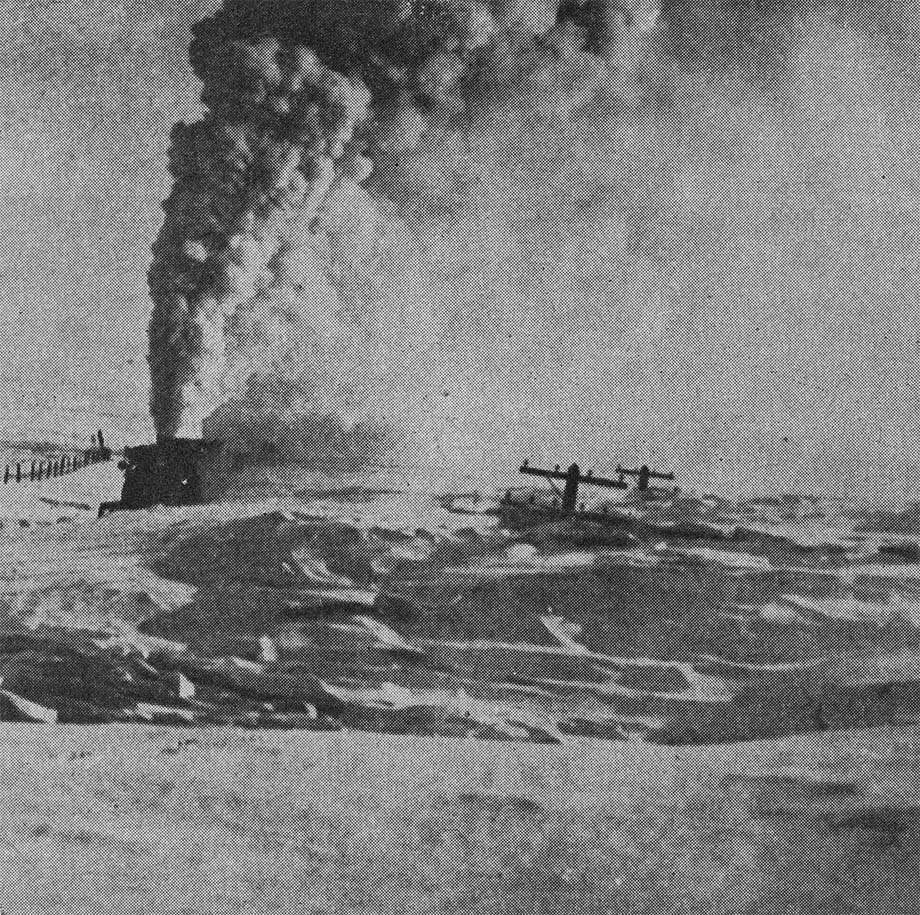
It showed on the train sheets as "Train 1 delayed 3 hours account broken drawbar."
Reading it in a warm office you might well wonder how it could take three hours to fix a broken drawbar. Watching the job with the mercury standing at 40 below and biting winds whipping sleet snow into the faces of the train crew, you might well wonder how they managed to get it done at all.
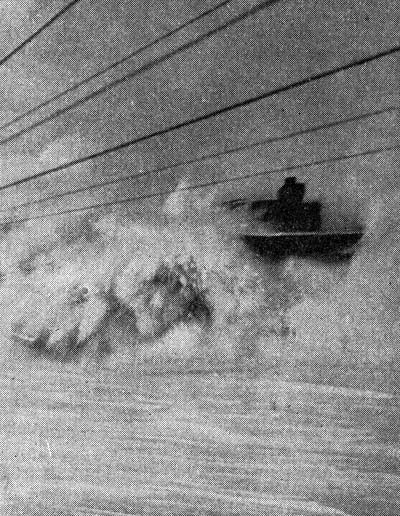
Yet this is just a sample of the manifold headaches meted out by the elements to railroaders on the prairie region during a sustained period of extreme cold unprecedented in 75 years.
The Alberta district was singled out for a particularly severe drubbing by the elements. That normally temperate district, home of the famed Chinook, got so much snow and frigid weather that even traditionally high-spirited Calgarians gave up trying to laugh it off.
Still another battle of men against the elements was being waged on the neighboring Pacific region with the 27 mile section of track between North Bend and Yale the main theatre of operations. Along this mountainous stretch of the Fraser canyon a 50 car freight train was half buried by cascading snow.
Counter attacking with traditional courage on all fronts were the gallant men who make up the railroad forces. Few employees were not affected in some way by the unruly elements and resulting traffic tie-ups. When the battle was finally won the record of the Company's personnel in the face of such adversities was still further enhanced.
The "Crow" line offered a striking example, and a cold one, of what prairie railroading has been like during the past winter. Here mountains of snow were pounded into an almost ice-like hardness by the cold winds, the kind they refer to out there as drifters. Then came a budding Chinook which, clashing with a Yukon cold front, emerged as a gale that at times hit a velocity of 60 miles per hour.
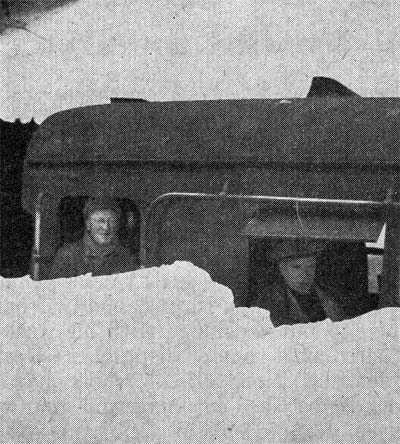
""That snow was just like cement when we were clearing it out," said Andy Montelbiti, roadmaster from Lethbridge to Crowsnest. "After the plows went through, the banks looked like rock salt."
Saskatchewan had the weatherman going way back to find a winter as cold. For 20 days it was 20 below or colder. Five of these days saw the mercury at 40 below or lower and on one occasion the thermometer registered a very frosty minus fifty. In addition to other hardships resulting from the sustained cold snap, deep freezing rivers and reservoirs cut down the normal flow of water.
Terminal points too had their troubles as slides in the mountains necessitated making up of extra locals. "You have easily twice the switching when that happens," explained W.F. Tully, general superintendent of the Manitoba district.
Field lived up to its reputation as the town where they give you five dollars if you can walk from the west yard to the yard pffice without turning your back to the wind when that wind is one of their infamous Yoho blows, the kind that makes 20 below feel twice as cold.
That was where Trevor Wood, superintendent of the Calgary division, explained how they named the "sugar slide" which they regard as one of their worst foes.
"See that stuff here," he remarked, "that ice snow is falling spilling down like sugar out of
the end of a bag." And it was doing just that. Every outgoing train had to follow a plow.
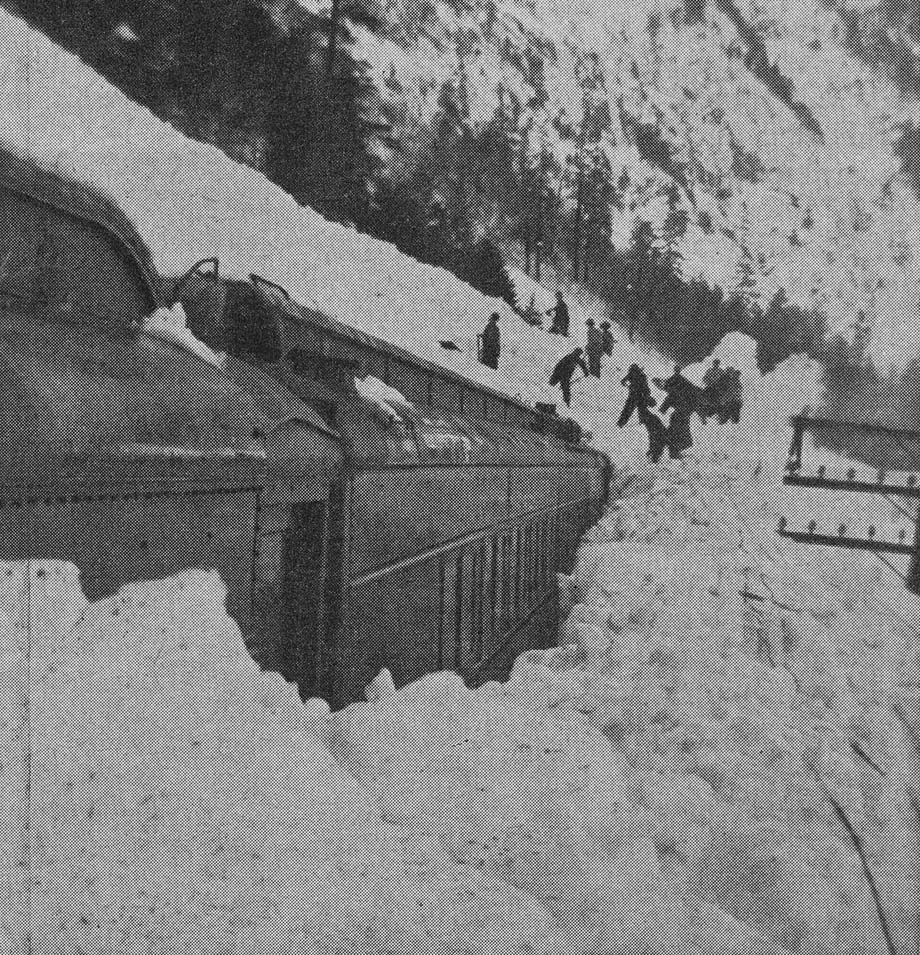
The early-to-bed policy did not apply to passenger men who virtually slept with an ear to the telephone.
Their duties were further complicated when unanticipated delays further wrecked what were already emergency
plans for moving snow-stalled passengers. Air lifts were in operation out of Calgary and Lethbridge in
co-operation with C.P.A.
Nor was the terminal passenger agent's lot a happy one with trains due at 06:10 Monday arriving at 04:30 the following day. Jack Stubbs and Bob Ritchie kept these long vigils at Winnipeg. "Knobby" Clark's reservation staff at Winnipeg brilliantly improvised on the many altered plans while information staffs were barraged with enquiries.
The Palliser hotel was a tower of strength throughout the emergency under manager Ron Deyell. The hotel was an effective linch-pin between westbound trains terminating at Calgary for a six day period and the air lift which took passengers on to their destinations.
Communications men thanked their stars that the summer program of "re-sagging" the lines had been carried out conscientiously. Cold contraction did pull the wires as taut as violin strings but the breakage was lower, a fact that was constantly blessed by track motorists who rode in the teeth of icy blasts to shoot trouble.
H.H. Enman's fuel department had its work cut out when "Crow" coal was all but temporarily knocked out of the picture by almost continuous blizzard conditions. This necessitated the careful planning of coal distribution from stockpiles to prevent tie-ups. It was also a continuous chess game trying to keep fuel oil stocks for mainline passenger traffic at safety levels.
E.G. Bowie, superintendent of motive power, and A.B. Burpee, superintendent of transportation, figured prominently in the battle which produced such further headaches as rearrangement of schedules, location of passenger cars, and the drawing up of a priority list for movement of empties and loads to and from the mines.
First major blow in the Fraser Canyon battle was dealt soon after a silver thaw loosened the heavy snows that blanketed the valley's slopes to unprecedented depths. As if on a given signal, tons of snow at points all along the canyon began to avalanche down on the tracks, ripping up trees and telegraph poles, and continuing on to the iced-up river below.
A crackling din in operators' headsets as lines were torn apart was the first warning of what was happening out in the night.
Even as the roar continued, the counter-attack was launched. An engine standing by with plough at Yale was manned for action and in 2 laborious hours pushed its way to North Bend.
But the battle that night was won by the elements. Although following hard on the wheels of the plough, a 50 car freight train was trapped while passing through a tunnel less than two miles out of Yale. Before help could arrive, half its length was buried under the cascading snow.
In the same desperate early morning hours a plough working in the opposite direction from North Bend crept as far as Saddle Rock, seven miles from Yale, where it too succumbed to snow which piled up faster than it could be removed.
All this took about six hours. In that time a train and plough were firmly stuck, other trains were waiting on the main line as far east as Kamloops and on the Kettle Valley line as far as Penticton, slides measuring up to 600 feet long and 35 feet deep littered the track from North Bend to Yale, new ones were rolling down and there was lots more snow where they came from.
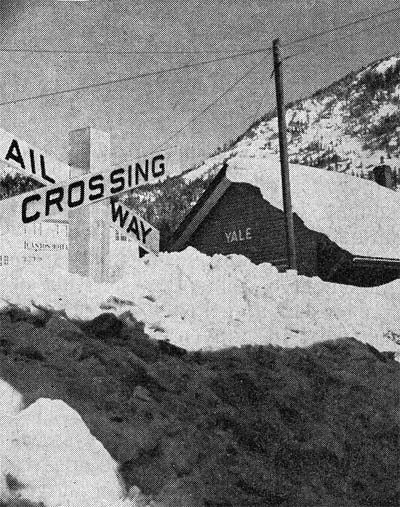
In the epic six-day battle that followed, and in the fight against new outbreaks which came with disheartening regularity for many days afterwards, one thing stood out, a driving determination to get the work going immediately and keep it going, which meant again and again "the C.P.R. gets through first."
But the measure of success is in the men who achieve it. There were men like young Bill Tessan, a D.P. in Canada for only 10 months, who was buried for 10 minutes under five feet of snow which suddenly pelted down on him. When fellow workers uncovered him, Bill was unconscious. But, on coming to, he wanted to go right on with the job and only under strong persuasion returned to North Bend for hospitalization.
There was big, booming roadmaster Alf Ades who, on the scene of action, saw the hour hand of his watch complete so many continuous circuits that he lost count. There was the crew of the rotary plough which blew a cylinder head with such violence that one of them was thrown bodily from the cab but continued with his work. There was chief dispatcher Bert Fagan at North Bend whose head, located between earphone and mouthpiece, occupied about six of the most important inches on the system at the time.
There were the passenger train crews who kept their charges happy during tedious days of waiting, and the unsung heroes who repaired communication lines. There was the tireless man on the shovel and the others in the engine hurling itself full tilt at a solid face of snow.
After four days of hacking, picking, and pushing at the stubborn blockade, during which lower temperatures helped although more snow fell, the climax was neared on 23 Jan 1950 when the freight train, caught out of Yale, was freed. The next day there followed what will probably go down in railway history as the Battle of Saddle Rock.
Directing the attack was G.H. Baillie, vice-president at Vancouver, who had as an assault team T.E. Price, Winnipeg engineer for maintenance of way, roadmaster E. Burlon, engineer G.F. Murray, fireman R.0. Wilford, and a crew of five shovellers.
Early 24 Jan 1950 their single plough engine, with caboose coupled behind, began the task of breaking through the mountainous heapings of snow extending as far as Saddle Hock which had almost been reached by the team working from the other side. Hour after hour their engine tore at the wall of snow, going into reverse at the last second so that with wheels slithering on the rails it would free itself on impact. Yard by yard the snow broke and yielded to the incessant battering.
By nightfall the last pile was pushed from the track and the engine steamed into Saddle Rock. Next day the
plough which had fallen victim to the snow on the first night was freed and the line to the east was
open.
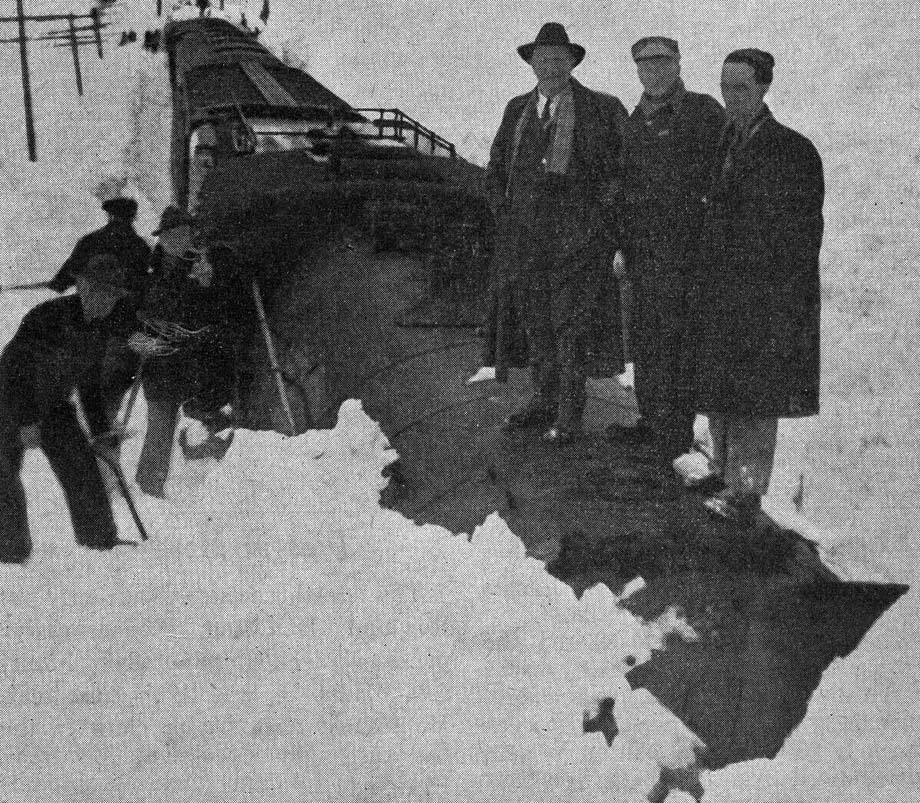
While this whole fight along the treacherous canyon wall was going on, another dramatic operation was in progress in the air. It was the all-up airlift, organized and put into action with cyclonic speed by Canadian Pacific Air Lines.
Operating on an emergency schedule set up by Jack Barber, district traffic representative, assistant Ken Razzell and chief dispatcher Tony Craig, the airlines transported a total of 1,109 passengers and 77,000 pounds of express between interior points and Vancouver.
Every available aircraft was pressed into the emergency service, and at the same time, regular schedule flights went on without interruption. Six aircraft, including the trans-Pacific Empress of Sydney, were used in the airlift.
Although hampered by bad weather and snow-clogged runways, flight crews kept the aircraft in the air as long as regulations would permit, flying as many as 17 special trips in one day.
For nine days after the rail line was cleared, trains rumbled endlessly in and out of Vancouver, bringing the city and interior points their first relief from threatening food and fuel shortages.
Then on the night of 3 Feb 1950 twenty inches of snow borne along on high winds fell on the canyon, again
the menacing sound came over communication wires and again the line was blocked. Again the clearance army
roared into action, again it opened the line, and still again the slides came.
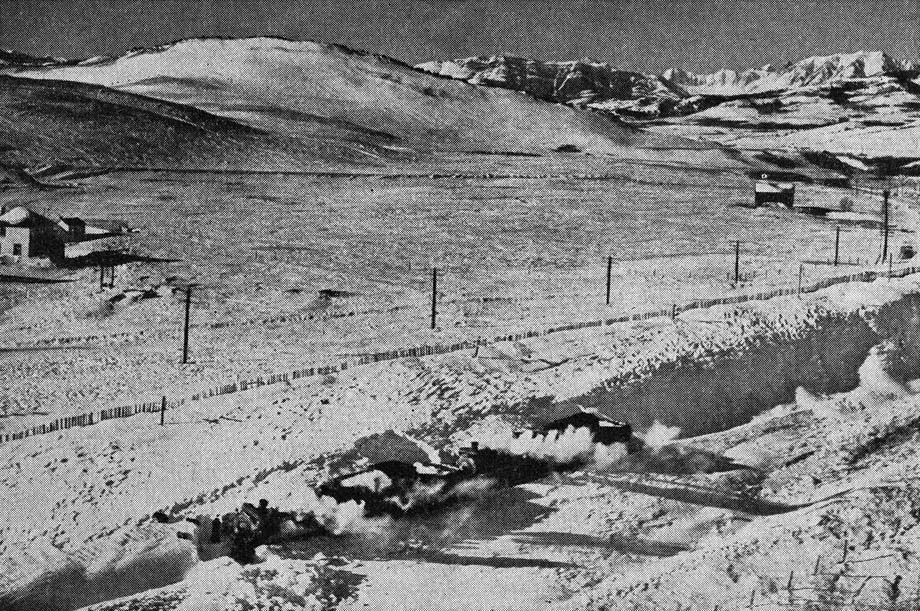
By this time the whole canyon seemed alive with rolling, slipping, snow as warm air breathed across the province.
The slides that came the night of 5 Feb 1950 caused particular dismay as they trapped and buried the first passenger train to be so caught since the trouble started. Again the setting was Saddle Rock where snow swooped down on an eastbound train carrying 37 passengers.
Rescue was quickly organized. In a few hours a path was hacked to the train, the passengers were brought out, and walking back along the path, boarded another train which returned them to Vancouver, none the worse for their adventure.
The canyon came alive again on 13 Feb 1950 as the temperature continued to climb. Again it was Saddle Rock where the piles built up but they were cleared away by next morning and fingers everywhere were carefully crossed.
Although the slides brought more than their weight in trouble, there was a lining to the cloud just as silver as the thaw that brought it. It was the chance it gave for all ranks and trades to get together in close vital action. The figures of Mr. Baillie, E.S. McCracken general superintendent, and G.L. Phillips superintendent, were familiar sights to the men in the thick of the trouble. In Vancouver Monty Thompson, transportation supervisor, and others around him maintained such an untiring vigil at the phone and telegraph key there could never be any doubt for those along the line about the kind of action they would get when needed.
For all participants in the struggle, perhaps the most significant reward was that the C.P.R. was first through every time.
 and is reprinted here with their permission. All photographs,
logos, and trademarks are the property of the Canadian Pacific Railway
Company.
and is reprinted here with their permission. All photographs,
logos, and trademarks are the property of the Canadian Pacific Railway
Company.